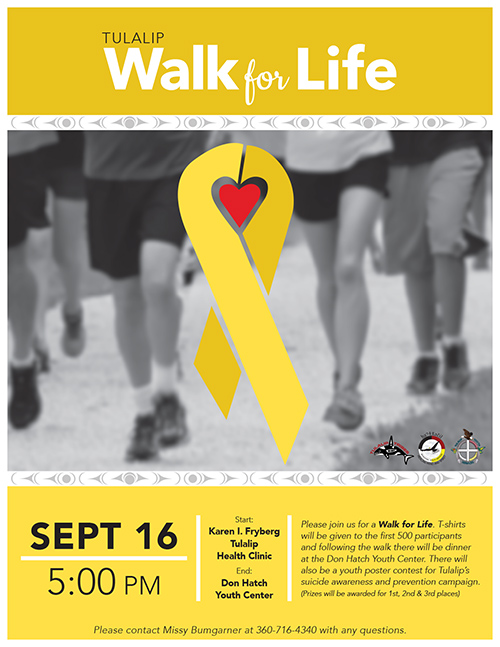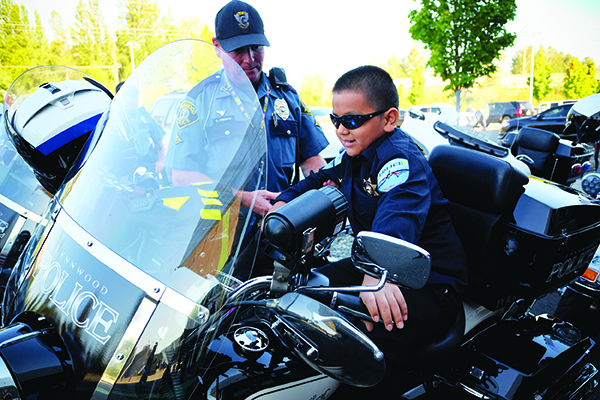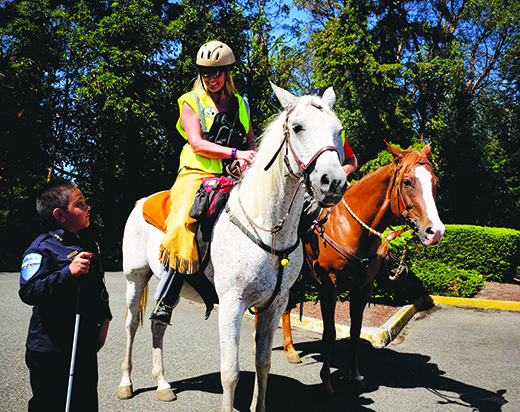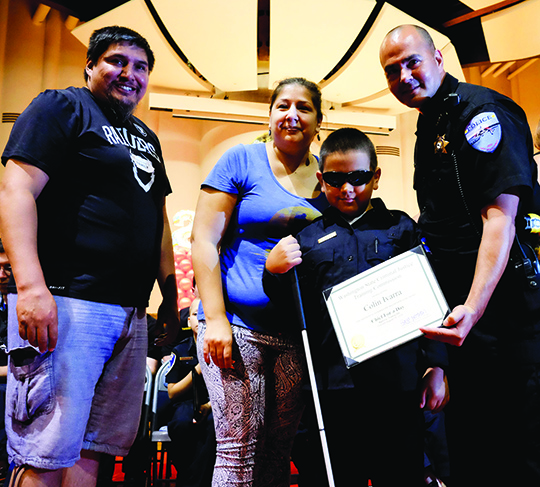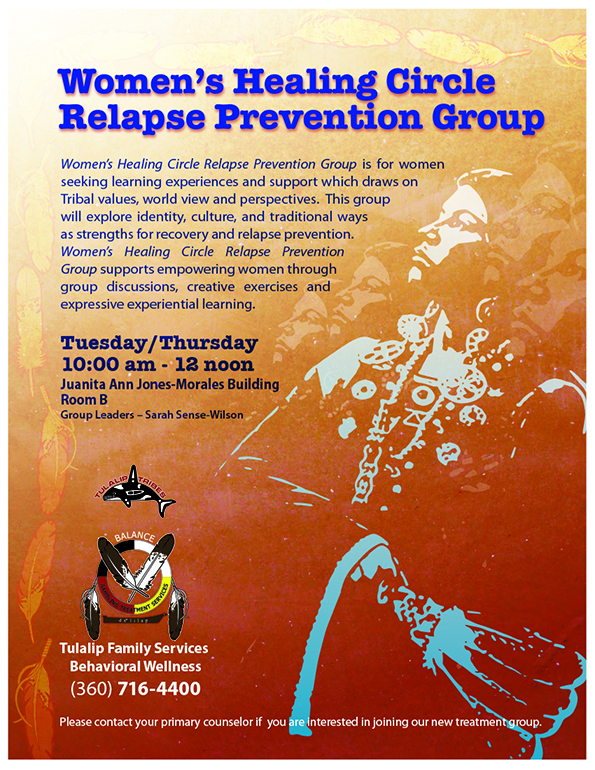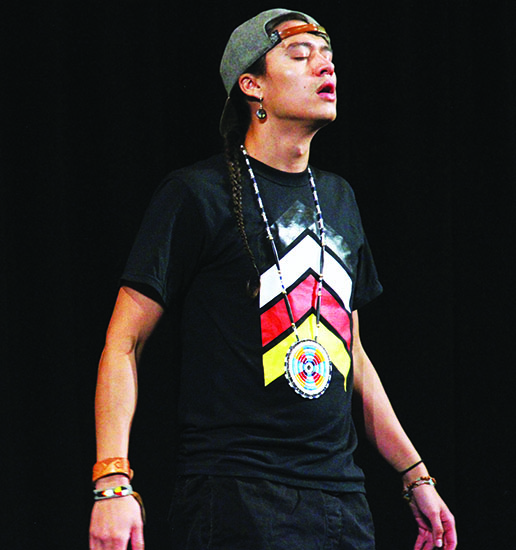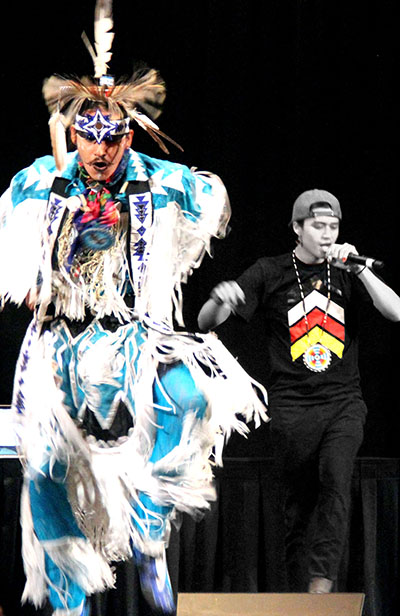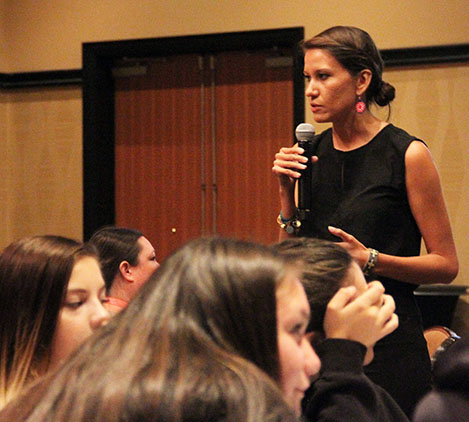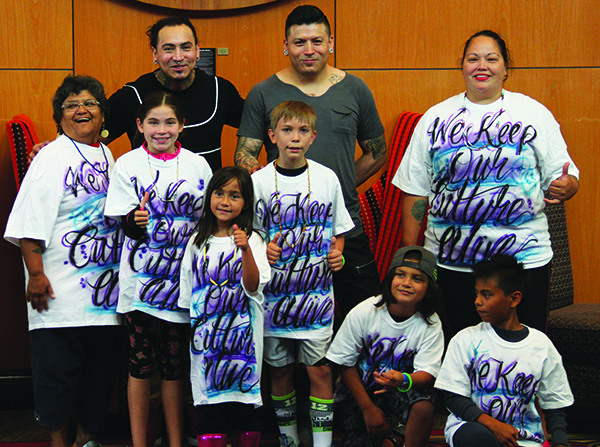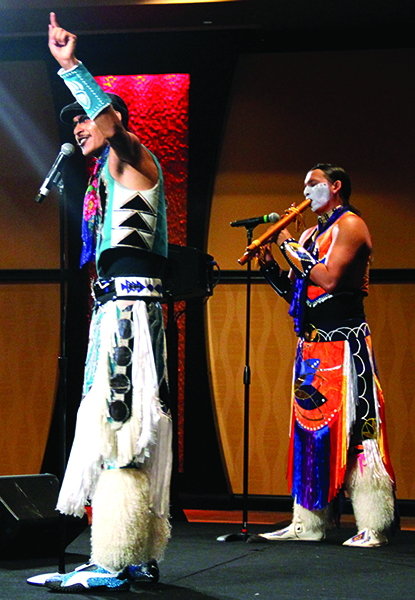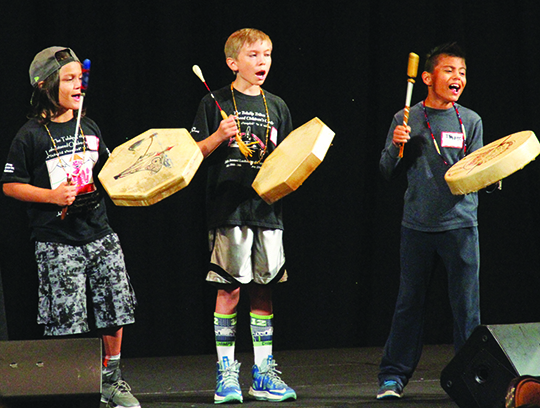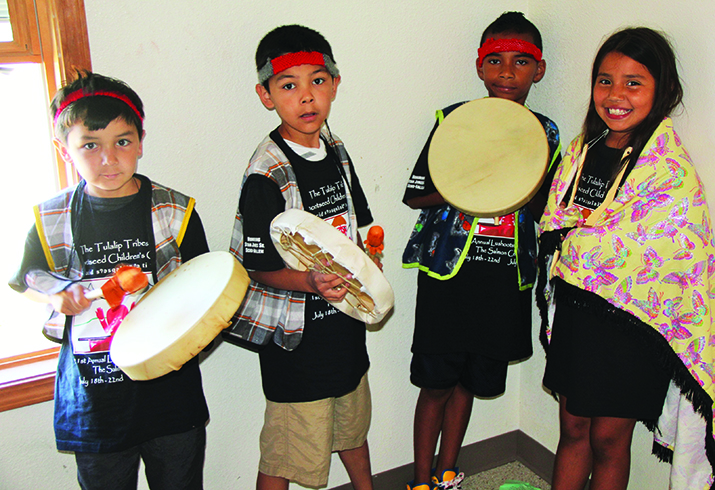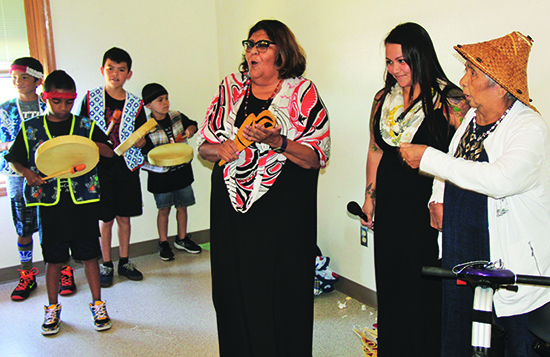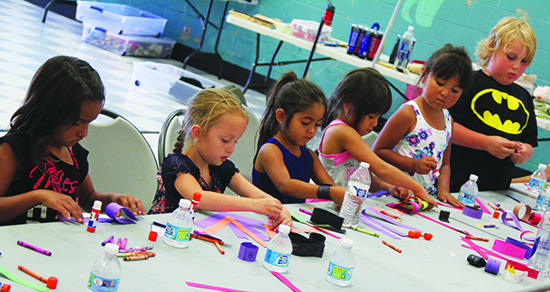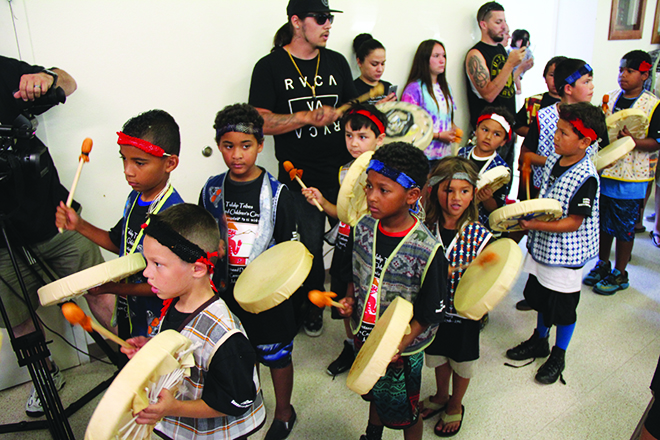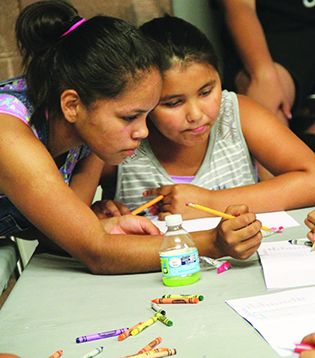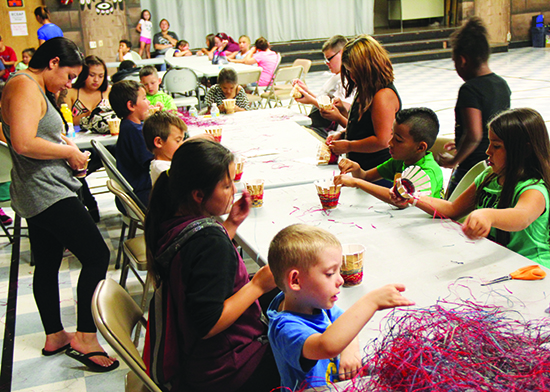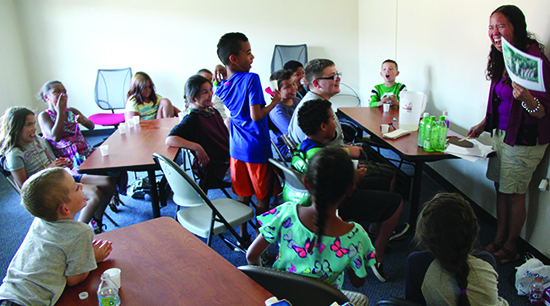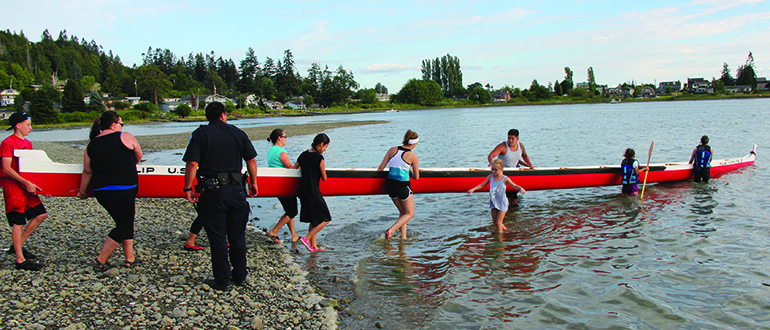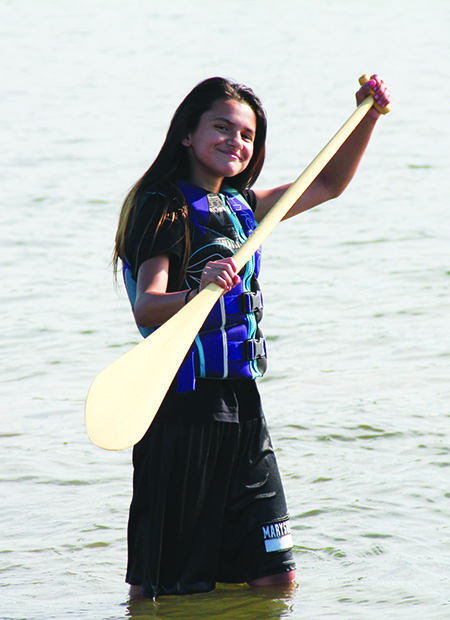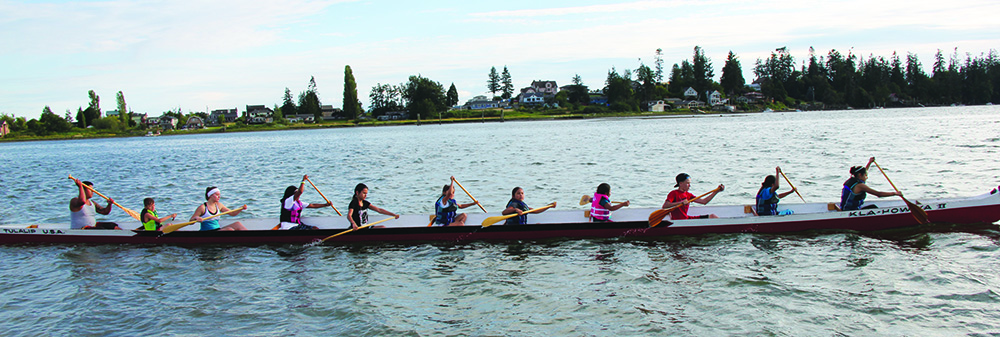Tulalip Walk For Life, September 16 at 5:00 p.m. Walk begins at the Karen I Fryberg Health Clinic and finishes at the Don Hatch Youth Center
Tag: Tulalip Tribes
Colin Ivarra, Tulalip’s Chief for a Day
Article by Kalvin Valdillez, Tulalip News
Photos by Tulalip police officer Joe Dyer
Helicopters, armored trucks, motorcycles, and multiple squad cars rolled into the city of Burien on August 18, 2016. All of these vehicles, some transporting precious cargo, were en route to the Washington State Criminal Justice Training Center. Many passengers in the vehicles were police chiefs hailing from multiple jurisdictions in the state of Washington. The ‘precious cargo’ is in reference to whom those police chiefs were handing over their reigns and titles to: the little chiefs.
Witnessed by police officers, family and friends, law officials held a swearing-in for local children to the honorary role of police chief. Kids who have been diagnosed with chronic illness and life threatening medical conditions were celebrated for the strength, love, and inspiration they show daily to their communities in an event known as Chief for a Day.
Among the dozens of police departments in attendance was none other than the one that protects our community, the Tulalip Police Department (TPD). Chief Carlos Echevarria made the trip to Burien to transfer his authority to a twelve-year-old Tulalip tribal member, decked out in a TPD uniform, Colin Ivarra.
Full of excitement and always sporting a smile Colin has reminded the Tulalip community about the power of optimism. Colin, who is visually impaired, has already won a battle, a battle that most people with similar conditions to Colin often fight their entire lives.
Colin has conquered self-acceptance. A lot can be said about the little chief – all of it positive. Colin radiates so much positivity and good vibes because he never allows being blind to interfere with having fun, being a kid, and most importantly, his values.
Although he might not know it yet, family is one of the values that Colin, taught by his Auntie Sarah Ivarra, practices everyday. A close-knit family, perhaps a main contributing factor, is Colin’s key to success. Sarah and his entire family have stood by his side, supporting him every step of the way in his young life.
Sarah stated that Commander Kenn Johnson personally contacted Colin to recruit him for the Chief for a Day event. In preparation for the event, Colin completed an ‘About Me’ questionnaire and submitted it to the TPD.
The event included police demonstrations, pony rides, face painting, and carnival rides. The highlight of the event was the swearing in ceremony. Chief Echevarria and Commander Johnson presented Colin with an authentic TPD badge and array of gifts personalized for Colin based on his ‘About Me’ quiz. The gifts included an iPod, toys, movies, camping gear, and Colin’s favorite gift, a scooter.
“It was awesome! I was excited cause I got to talk and control a robot, I watched some people get tased, there was a robot boat, and free ice cream,” Colin exclaimed about his experience as little chief of Tulalip. “It was sooo cool, everyone is nice and the gifts are really cool.” His advice to future little chiefs is simply to have fun.
“It was just really nice to see [Colin’s experience] so personalized,” Said Sarah. “It is great to see him honored.
Sarah thanks the TPD, especially Chief Echevarria, Commander Johnson, and Officer Dyer for honoring Colin and accompanying him to the event.
“I really want to be Chief again in a couple years, when I grow up,” expressed Colin. With a goal set in place and a great supporting cast, Colin is now stepping into a lead role, in which he portrays resilience, more exciting and important than any blockbuster on the big screen this summer. A role that promises to grab the attention of it’s viewers immediately. An action-packed story that will involve plenty of good laughs and happy tears, the story of a future Chief, Colin Ivarra.
Tulalip-based Juvenile Diversion Panel seeking additional volunteers
By Wendy Church, Tribal Court Director
Since starting the juvenile diversion panel (known as the Tulalip Community Accountability Board) in July 2009 here on the Tulalip Reservation, the C.A.B. has heard 58 cases so far. This diversion program is an alternative to the juvenile court process.
The C.A.B. meets monthly with tribal member youths under the age of 18 years old who are arrested for minor offenses and are eligible for participation in this program. Objectives of the panel are to hold the youth accountable for their actions, foster a change in the youth’s attitude, impress upon the youth the community is concerned about their conduct, increase the youth’s awareness of impact their behavior has; and to maximize opportunities for the youth.
We are actively recruiting additional volunteers for the Tulalip-based C.A.B. Volunteers must possess an interest in youth and commitment to the welfare of others; have a non-judgmental attitude; treat youth and families with dignity and respect; have the ability to hold confidences and respect others privacy; have the ability to communicate effectively; have the ability to work and problem-solve with other volunteers; and have prior experience with youth.
The C.A.B. meets once a month at 5:30 to 7:30 p.m. at the Tulalip Tribal Court.
If you are interested in being a volunteer, please contact Emmy Hoff, Juvenile Probation Counselor at the Denny Juvenile Justice Center for an application. Applicants will be screened for any criminal record and will be required to attend a 2-hour training. Ms. Hoff can be reached at 425 / 388-7917.
Women’s Healing Circle Relapse Prevention Group
by Sarah Sense-Wilson
The Tulalip Tribes Family Services Women’s Healing Circle –Relapse Prevention Treatment Group, is a cultural based approach to supporting Native women in their efforts to address relapse prevention within the context of community, family and individual. The Women’s Healing Circle meets twice a week (10:00am-12noon) Tuesdays/Thursdays for 6 weeks at TFS. We include Native perspective, worldview and culture specific exercises and activities which build on strengths, and supports a holistic approach for wellness and health. Our Women’s Healing Circle group is designed to incorporate traditional universal Native values and beliefs for enhancing identity and fostering healthy relationships. You must be enrolled in TFS chemical dependency treatment program for participation in Women’s Healing Circle group. Please contact TFS for more information at 360-716-4400
AbOriginal Soul: Annual Tulalip Wellness Conference (Day 3)
“Got this history in my blood
Got my tribe that shows me love
So when I rise,
You rise.”
–Frank Waln
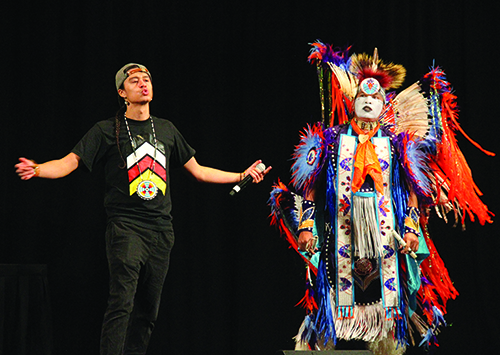
“It comes down to the decisions you make in your life. Most of the time the right choice isn’t the easy one. It’s easy to run away. To run away to drugs and alcohol and I’m not judging, but I am here today because I’m always making the difficult choice,” stated Native American Hip Hop Artist and Motivational Speaker Frank Waln. Along with Tanaya Winder, Megan Red-Shirt Shaw, and The Sampson Bros, Frank closed out the final day of the Annual Community Wellness Conference at the Tulalip Resort and Casino on August 11.
Frank shared his entire life story with the future of the Tulalip Tribes for one reason: inspiration. The history of Native America isn’t well known to the rest of the world. Our story is often watered-down or not mentioned at all in schools throughout the United States. Growing up as a Native American in today’s society, we always had difficulties finding role models that weren’t appropriated by stereotypes. Frank easily flipped the script by actively advocating Native American rights, and is clearing up any misconceptions during the process.
Now in his mid-twenties, Frank spoke to the youth about everything he went through as a young Indigenous man. From a fatherless childhood to the culture shock of leaving his reservation for college, Frank has seen it all in only 27 years.
Frank spoke about his own experiences with drugs, alcohol, depression and suicide, so the youth can identify when they are caught up in one of those life-threatening cycles and can ask for help. More importantly, he shared those experiences so the youth, who might be going through a difficult time right now, could relate. He let them know that they aren’t alone, and how finding a healthy outlet is crucially important because it can break those cycles.
Before Frank took to the stage to perform his music, three of his colleagues and close friends shared their uplifting words with the conference attendees. Frank’s long time friend, fellow activist, dancer, and half of The Sampson Bros, Micco, encouraged the youth to follow their passion and to give it everything they got. Poetess, activist, and Frank’s manager, Tanaya Winder, performed poems from her new book Words Like Love and spoke about losing a loved one to suicide. And activist, writer, and founder of Natives In America, Megan Red-Shirt Shaw, talked with the community about finding and utilizing your voice while encouraging the youth to pursue higher education.
In between speeches, airbrush artists from Dzul Ink were at hand, making custom t-shirts for the youth with slogans such as Smoke Salmon Not Cigarettes and Pizza Rolls Not Gender Roles. Each person in attendance had the opportunity to choose a slogan they wanted to advocate for and the Dzul Ink artists created the t-shirt while the youth enjoyed the performance by Frank Waln and The Sampson Bros.
The perfect way to end any conference is with a musical performance. Frank and Company took it a step further by incorporating the message they were expressing with the most influential genre of music in the past three decades, hip-hop.
Frank performed some of his notable songs including AbOriginal and My Stone and debuted a new track, What Makes A Red Man Red, which samples dialogue from the Disney classic, Peter Pan. The inspiration for the new song came from the frustration of how Tiger Lily and Native Americans are portrayed in the movie.
While Frank passionately spit bars over beats he made on his own, the Sampson Bros performed along side him playing the flute and both fancy and hoop dancing. Micco shared the story of how he met Frank followed by spoken word poetry he wrote for his father, Will Sampson, who played Chief Bromden in the classic film adaptation of One Flew Over The Cuckoo’s Nest.
The event was a success from the first day to the last. Each speaker gave the youth something to reflect upon and let them know they are loved, because sometimes when people get caught up in the everyday struggle it can be hard to overcome the overwhelming pressure of todays society. Sometimes we get lost in depression created by multi-generational trauma, and we desperately search for an escape. The wellness conference not only acknowledged that depression and anxiety are disorders that Native Americans are suffering from on every reservation, but also gave the Tulalip community healthy ways and the tools to help cope with those disorders.
Honoring the past, Impacting the future
21st Annual Lushootseed Day Camp
By Micheal Rios, Tulalip News
During the sizzling, summer days of July 25-28, the old Tulalip Elementary gymnasium was glowing with rays of joy as it was home to the 21st Annual Lushootseed Day Camp, week 2. The camp was open to children age five to twelve who wanted to learn about their culture and Lushootseed language through art, songs, games, weaving and storytelling.
Each year the Lushootseed Department teams up with the Cultural Resources Department, along with a select number of very vital community volunteers, to hold two one-week camps. Each camp has openings for up to 50 participants, but this year the demand was so high that 64 kids participated in week one, while a whopping 80 kids comprised Language Camp week 2.The two-week total of 140+ Tulalip youth involved in Language Camp smashed the record for youth participation and attendance.
“We are dedicating the 21st Annual Lushootseed Language Camp to Morris Dan and Harriette Shelton-Dover, for their guidance and teachings bringing back the Salmon Ceremony, as well as honoring Stan Jones Sr. “Scho-Hallem” for his decades of leadership and determination to keep the ceremony going,” said Lushootseed language teacher and co-coordinator of the camp, Natosha Gobin. “This year we are recreating the Salmon Ceremony to pass on the teachings to our youth. Vests and drums will be the regalia made for the boys, while the girls’ regalia will be shawls and clappers.”
Using the 1979 Salmon Ceremony video to help pass on the earliest teaching of what is still practiced today, the young campers learned a selection of highlighted songs and dances. The lessons learned each day during Language Camp were based on the teachings of the Salmon Ceremony by way of songs and dances, traditional teachings, language, art, weaving, and technology. The goal this year was to provide our youth with some basic regalia along with the knowledge and ability to sing and dance. Staffers hope the youth that have participated have the teachings and experience needed so they will stand up and sing at every opportunity.
Throughout the duration of camp, the children participated in seven different daily activities. The following list is what each child accomplished throughout the week:
- Art – Salmon bracelets, Salmon hands, paddle necklaces.
- Weaving – Pony Bead loom beading, small raffia baskets.
- Songs and Dances – Welcome Song, Eagle Owl BlueJay Song, Snohomish Warrior Song.
- Traditional Teachings – Salmon Ceremony videos, traditional stories, realia experience in traditional story and science face of how Salmon migrate.
- Games – Various games and playground time.
- Language – letter sounds, Salmon Ceremony key words, Lushootseed workbook.
- Technology – children learned and practiced Lushootseed materials related to Salmon Ceremony using the Nintendo DSi handheld games created by Dave Sienko.
The closing ceremony for week two’s camp was held on Friday, July 30 in the Kenny Moses Building. The joyous, young play-performers made their debut to a large community attendance, as family and friends came out in droves to show their support.
“I want the kids to know that I love each and every one of you. When teachers are new to our community and they hear their Principal telling kids ‘I love you’ it’s foreign to them, but it’s one of our most important traditional teachings,” stated ceremonial witness Dr. Anthony Craig, former Principal of Quil Ceda Tulalip Elementary. “We have to make sure we are expressing love every single day, otherwise people forget that it’s a traditional teaching. I love that they are here today and I love that they practicing their culture because culture is not something that just exists in a building or during a season. Culture is every day; every day we have to figure out ways to strengthen our culture and here they are doing that.”
Also in attendance to witness the youth Salmon Ceremony were two very special guests. The 21st Annual Lushootseed Language Camp was dedicated to the late Morris Dan, our Swinomish relative, and the late Harriette Shelton-Dover, our Snohomish relative. Together Morris and Harriette brought back the teachings, songs and dances to the Salmon Ceremony that is still held yearly in Tulalip. Neah Martin, daughter of Morris Dan, and her daughter Merla Martin, oldest granddaughter of Morris Dan traveled to Tulalip to witness the teachings of their father and grandfather being honored by Tulalip’s next generation.
“I’m glad that all you children honored these beloved elders here today,” said Merla Martin, who was one of the lead dancers in the 1979 Salmon Ceremony video that the children learned from. “I’m very happy the teachings are still being passed on. Thank you for honoring my grandfather.”
After the youth performed their rendition of Salmon Ceremony and the ceremonial witnesses had shared a few words, there was a giveaway. The camp participants gave handmade crafts to the audience members, which preceded a salmon lunch that everyone thoroughly enjoyed.
Reflecting on the conclusion of this year’s 21st Annual Language Camp, Natosha Gobin beamed with pride, “My spirit is so happy. My heart is full. I raise my hands to each of the 140-plus kids who spent time with us to learn the teachings, rising up to sing, dance and carry these lessons on for the next generations. I’m grateful to the volunteers for giving their all to our youth while mentoring them daily during camp. You have created lifelong bonds with them and they will continue to look to you for guidance. My co-workers busted their buns planning, prepping, working, making sure every detail was taken care of. To all the parents we say ‘thank you’ from the bottom of our hearts for sharing your kids with us and showing them their language, culture and teachings are relevant!”
‘Since Time Immemorial’ Training Gets a $600K Boost
A state law requires schools in Washington to teach students the history of the state’s 29 federally recognized indigenous nations, just as they teach U.S. and state history.
School districts that have adopted the “Since Time Immemorial” curriculum, which was formerly “encouraged” but is now mandatory, say the curriculum is an easy tool to use. But the curriculum encourages participation with local Native nations. “Our goal is to teach WITH tribes, rather than about them,” the curriculum states—and one of the challenges school districts report is developing the partnerships to make that happen.
RELATED: From ‘Encouraged’ to Mandatory’: Schools Must Teach Native History in Washington
Training now underway is helping to build those associations.
“Our [curriculum] trainings have doubled in both size and frequency” since the law made implementation of the curriculum mandatory, Michael Vendiola texted on July 27 from a conference in Omak on the Colville reservation. Vendiola, Swinomish, is program supervisor for the state education department’s Office of Native Education. “We are training more dynamically as well. For example, we are training more curriculum teams, administrators, and education associations.”
The training is getting a boost from Western Washington University’s Woodring College of Education, which received two grants totaling $600,000 from the Washington Student Achievement Council, a cabinet-level state agency.
“These two grants not only advance our professional development work in schools but, most significantly, forge important new efforts with Native American communities in our region,” Woodring College of Education Dean Francisco Rios said in an announcement of the grant. “It capitalizes on the strengths of our faculty while also honoring the important cultural knowledge of local indigenous communities.”
Of the funding, $400,000 is being invested in “Implementation of Since Time Immemorial: Higher Education and K-12 School Partnership Pilot Project,” a collaboration of Woodring College, The University of Washington, Western Washington University, and the state Office of Native Education.
The project will assist schools and districts that have a high number of Native American students, including Chief Kitsap Academy, which is owned and operated by the Suquamish Tribe and serves Native and non-Native students; Lummi Nation School; Marysville School District, which serves students from the Tulalip Tribes; Muckleshoot Tribal School; Shelton School District, which serves students from Skokomish and Squaxin; Taholah School District, which serves students from the Quinault Nation; and Wellpinit School District, which serves students from the Spokane Tribe.
State Sen. John McCoy, D-Tulalip, who authored the curriculum law, said it’s important that Native nations be involved because the curriculum is “only a baseline curriculum.” The curriculum includes such topics as “Exploring Washington State —Tribal Homelands,” “Washington Territory and Treaty Making,” “Being Citizens in Washington: The Boldt Decision,” and “Encounter, Colonization and Devastation.” But those courses are not localized; the involvement of local indigenous nations can help students understand those subjects on the local level.
The project is providing training workshops, professional development and coaching to teachers, administrators and paraprofessionals.
“Our entire team of diverse partners is dedicated to providing professional development that teaches regional tribal government, culture and history through the STI curriculum,” said Kristen French, associate professor of elementary education at Western Washington University.
“We are thrilled to have this grant because we can contribute and build on the good work that [the state Office of Native Education] and state Sen. John McCoy have done to improve Indian education,” she said, adding that six of seven team members are Native women trained in education.
Vendiola’s wife, Michelle, is “Since Time Immemorial” grant coordinator at Woodring College.
“With an emphasis on culture and identity, we expect this work to have long-term impact on the academic achievement of Native students, as well as all Washington state students,” she said in the grant announcement. “Ultimately, we are honored to participate in the improvement of future relationships between tribal communities and mainstream Washington state citizens.”
An example of how the involvement of local Native nations can bolster knowledge of Native culture and the environment Native and non-Native students share is “Science and the Swinomish,” a collaboration of Western Washington University, the Shannon Point Marine Center and the Swinomish Tribe.
The project received $200,000 in funding to train teachers and administrators in the La Conner and Concrete school districts, two districts serving Swinomish students.
The partnership will “personalize the STI curriculum and develop hands-on science lessons focused on the restoration and care of the environment essential to maintaining the traditional Swinomish way of living,” said Tim Bruce, an instructor at Woodring College.
Teachers and principals will receive training in the basics of the curriculum and then will dig deeper into the aspects that relate to science, focusing on locally relevant, culturally important topics such as salmon recovery, tideland impacts and water use—topics that affect everyone.
Organizers say teachers and principals will have a strong working knowledge of the curriculum by spring 2017, and will have multiple lesson plans ready for submission to a digital library where they can be shared with a wider audience.
Vendiola said feedback received from curriculum partners is helping educators innovate the curriculum in new ways.
A pre-K/early learning curriculum, titled “STI Tribal Sovereignty Early Learning Curriculum,” is a partnership of Thrive Washington—First Peoples, First Steps Alliance, and the Puget Sound ESD Native American Early Learning Project. “There are currently three pilot lessons availablefor the early learning community,” he said.
Giving Balance to History Instruction
Thirty percent of school districts in Washington are using “Since Time Immemorial,” which was developed by the state in consultation with indigenous nations in Washington.
The legislation that established STI seeks to give balance to history instruction, which has often ignored the state’s indigenous history. It also seeks to improve student knowledge of indigenous history and culture; foster cross-cultural respect and understanding; and bolster cultural sensitivity in all students.
“We do have a rich, solid history in the state, and it should be taught,” McCoy said in an earlier interview. Doing so would help students understand sovereignty and the work that indigenous nations do in their historical territories—authority that many elected officials don’t understand, McCoy said.
In addition to the above projects, regional training will be hosted in October by the Toppenish School District, on the Yakama Nation reservation; Education Service District 113, in the state capital of Olympia; the Port Gamble S’Klallam Tribe, whose students attend schools in the North Kitsap School District; and the Lummi Nation, whose students attend Lummi schools or schools in the Ferndale School District.
Read more at http://indiancountrytodaymedianetwork.com/2016/08/03/time-immemorial-training-gets-600k-boost-165325
US HealthVest breaks ground on new Smokey Point Behavioral Hospital
New hospital fills unmet need for behavioral health in Snohomish County and beyond

MARYSVILLE, Wash. – (July 26, 2016) –US HealthVest and construction services firm, Mortenson Construction, broke ground today on the Smokey Point Behavioral Hospital at 3955 156th Street Northeast in Marysville. The new 115-bed hospital will provide a full continuum of behavioral health and addiction treatment—including inpatient and day-hospital services—to children, adolescents and adults.
With this new hospital, US HealthVest can extend much-needed services to patients north of Seattle, where communities are experiencing rapid population growth and a heightened need for behavioral healthcare. Specialty programs at Smokey Point will be tailored to the women’s population, patients with co-occurring disorders, the Native American population, veterans, youth, the senior adult population and faith-based groups.

The Washington State Institute for Public Policy found that Washington has one of the highest prevalence rates for adults with mental health disorders in the country, yet ranked nearly last among all states in the total number of psychiatric beds available per person. Additionally, nearly all hospitals providing adult psychiatric care in Washington had daily occupancy rates exceeding 80 percent compared to 64 percent in community hospitals in the US; 24 percent of Washington adults met criteria indicating a mental health disorder – the third-highest rate of all states; and approximately 7 percent met further criteria for a serious mental illness that interfered with daily life — ranking Washington No. 2 in the nation.

The two-story, 71,000-square-foot building was designed by Seattle-based architecture firm CollinsWoerman and will offer semi-private patient rooms, an outpatient clinic and support space including a pharmacy and food service administration. There will also be indoor and outdoor recreational activity areas. Mortenson anticipates the hospital will be completed in summer 2017.
Tulalip Mountain Camp Registration Ends July 29
Little pullers, big ambitions
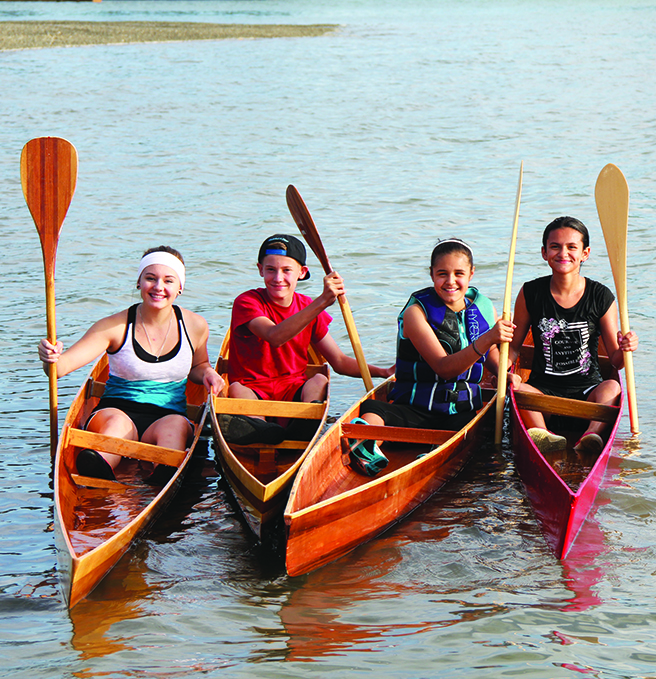
By Micheal Rios, Tulalip News
Through the commitment and guidance of several Tulalip tribal members, led by Natasha Fryberg, the Tulalip Tribes has its very own youth canoe club. They’ve been practicing three times a week, rain or shine, since April. With a consistent turnout of kids and their dedicated parents, the canoe club has established itself as a safe and fun activity for our youth to practice traditions of our ancestors.
“For most of these kids, this was their first ever experience with pulling canoe. We teach them the skills and proper technique outside of the canoe first,” says Natasha. “We really focus on each kid’s individual comfort level, so that they enjoy their experiences in the water and in the canoe.”
The current age range is of club members is 5-years-old to 16-years-old, with a good mix of boys and girls. A goal of Natasha and her fellow instructors is to train the canoe club members to the point they can participate in the war canoe races circuit. Thus far, the future is bright as the kids have really taken to the water and enjoy the rigorous activity of war canoe racing during their practices.
“My kids had zero previous experience with canoe pulling, let alone being in a canoe until now,” says Nickie Richwine, mother of three daughters participating in the canoe club. “It’s been an honor to watch these kids excel on the water. I’m so thankful for their coaches Natasha and Tawny Fryberg, Alicia and Clayton Horne, and Ryan. They’ve really been a blessing for taking the time to teach and encourage our kids to be on the water.”
For those interested in getting their kids involved with Tulalip’s youth canoe club, please contact Natasha Fryberg at 425-422-9276.

